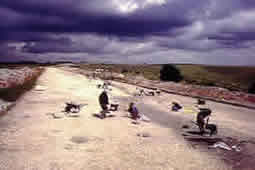Evidence of Late Bronze Age and Iron Age (800BC – 200 BC) settlement was found by Wessex Archaeology close to the Iron Age hillfort at Battlesbury Camp near Warminster in Wiltshire.
In 1998 we were brought in on behalf of Defence Estates to excavate land at the western edge of a planned 15-mile tank road running across Salisbury Plain from near Warminster to Tilshead.
For four months around 20 of our archaeologists, including volunteers from a local historical society, stripped the soil down to the chalk in an area a third of a mile long. Their finds included 170 ancient pits and 700 holes where wooden posts had been placed.
We found six human skeletons in four pits. Five were men and women aged 30 to 40 and one, who was buried with a Neolithic axe (4,000BC – 2,400BC), was probably a boy aged about 10. Human bones were also found in another 14 ditches, gullies and pits at the site.


Our staff believe that as well as burying corpses, the people at the site exposed many of their dead to the elements to decay, possibly on raised platforms. This ritual – excarnation – was part of a religious rite of passage into the next life. Articulated bones
The archaeologists also found holes for wooden posts that were part of three roundhouses about 25 feet in diameter, all with their entrances facing either east or southeast, so catching the sunrise at the equinox and winter solstice. This shows how important it was to record the seasons so that ploughing and sowing were timed correctly. They also found evidence of ten granaries.
The archaeologists also found cattle, horse and dog skulls placed in a ditch to symbolically mark an en entrance to the camp which had been blocked off. Evidence of the way of life of the inhabitants was also found, including bone combs for hair and textiles, bone needles, clay slingshots for hunting and spindle whorls for spinning wool. A rare coral bead from the Mediterranean found at the site points to long-distance trade.
Chris Ellis, who managed the archaeological work on the site, said: “The evidence from this site gives us another way of looking at the Iron Age and the individuals who lived at that time. The people living here probably had a much different view of the world than we do today.”
So far it has not been possible to link the settlement with the Battlesbury Camp hillfort, which was probably several hundred years later. We are still carrying out work to analyse the finds.

